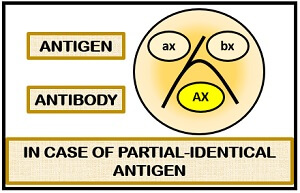A precipitation reaction is a test involved in the serology, for the qualitative and quantitative detection of antigens and antibodies. It is a reaction, where the soluble reactants (antigen and antibody) convert into an aggregated form. The sensitivity of the precipitation reaction is comparatively less than the other immunoassay reactions.
For the precipitation reaction, polyclonal or multivalent antibodies and antigens are used because the lattice formation will not occur in case of monoclonal Ag and Ab. For a precipitin ring or band’s appearance, the reaction may take a few hours to days. Precipitation test is used to quantify both antigen and antibody, and its specificity also depends upon the concentration of both the reactants.
If anyone’s concentration (either antigen or antibody) exceeds, the immunocomplex will not form. For the reaction to occur, the concentration of both antigen and antibody must be equal, which in turn produce a visible mass of precipitate or lattice. Thus, the end product appears as a precipitate, which can be measured by devices like turbidometer and nephelometer.
Here, we will focus on the definition, principle and methods of the precipitation reaction in solution and agar (by diffusion and electrophoresis) along with the meaning of some important terms relative to this context.
Content: Precipitation Reaction
Definition of Precipitation Reaction
A precipitation reaction is an immuno or serological assay where the two reactants, i.e. both antigen and antibody diffuse either in one dimension or two dimensions in liquid or semi-solid media. The antigen and antibody react with each other to form an immunocomplex or lattice at the zone of equivalence (Abs and Ags are at equilibrium). The lattice formed by antigen and antibody is visible, either in the form of precipitin ring or in the way of precipitin line. Precipitin is an antibody which reacts with a respective antigen to form a “Precipitate”.
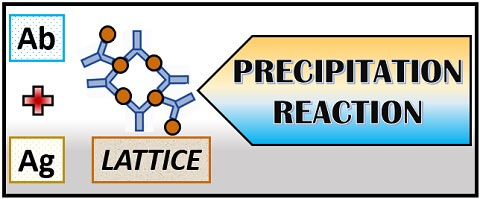
Important Terms
There are specific terms, which we should know before proceeding to the theory of precipitation reaction.
- Precipitin: The soluble antibodies behave like precipitins, which react with the soluble antigens and bring a precipitate formation in the form of a visible insoluble mass.
- Precipitinogen: The soluble antigens act like precipitinogens, which induce the formation of precipitin, i.e. soluble antibody.
- Lattice: It appears as a cross-linked structure formed by the cross-linking of Ag and Ab to form an immunocomplex.
Principle
A precipitation reaction is based on the principle of “antigen-antibody reaction”, which occurs at the equivalence zone. At the equivalence region, the ratio of both antigen and antibody is equal, which brings out the formation of lattice or cross-linked structure. In the equivalence zone, cross-linkage occurs between the reactants that result in the formation of the antigen-antibody complex as a visible ring or line of a precipitate. The least soluble antigens and antibodies form a complex at the point of equivalence, whereas the free antigens and antibodies remain as the supernatant.
Methods
Based on the type of matrix, the methods of precipitation reaction include:
Precipitation in Solution
In this type, the precipitation method is performed in the liquid media or solution. It consists of two methods, namely a ring and flocculation test.
Precipitation Ring Test
In the ring test, the antibodies which are present in the serum is first taken in the test tube. After that, test antigen is added to the solution. Then, over incubation of the reactants, the precipitation reaction occurs between antigen and antibody and a white precipitate forms at the junction.

Flocculation Test
This test can be performed in either of the two ways:
- Slide flocculation test: In slide test first, the drop of antiserum is added onto the clean glass slide. Then over the antiserum, a drop of test antigen is added, followed by thorough mixing. If clumping between antigen and antibody occurs, the slide test will give a positive result and vice versa.
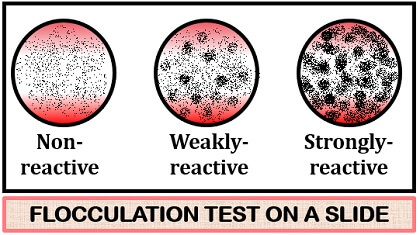
- Tube flocculation test: In this, the procedure is the same as slide flocculation test, but the only difference is that it is performed in a test tube instead of slide. The example of tube flocculation tests is RPR (Rapid Plasma Reagin) and VDRL (Venereal Disease Research Laboratory) test.

Precipitation in Agar by Immunodiffusion
In this type, the precipitation method is performed in the ordinary media like nutrient agar media. Immunodiffusion takes place through the intervening agar media whose rate is influenced or affected by the following factors like:
- The particle size of the reactants
- Temperature
- Gel viscosity
- Interaction between gel matrix and reactants
The preferred concentration of agar is between 0.3-1.5 percent for the effective diffusion of the reactants to form a lattice. In agar, diffusion takes place by either of the two ways:
- Single diffusion
- Double diffusion
Single and double diffusion can occur both in one dimension and double dimension. One dimension diffusion involves the diffusion of either antigen or antibody on the agar gel. Double dimension diffusion consists of the diffusion of both antigen and antibody on the solid agar media. The precipitation reaction by immunodiffusion includes four methods that are explained below:
Oudin Immunodiffusion Method
It is a type of single immunodiffusion method, which occurs in one dimension. In Oudin immunodiffusion, add antibodies in the molten agar media and pour it into the petri dish.

After solidification of the gel matrix, add a layer of soluble antigen. As a result, the incorporated antibodies in the gel matrix will not diffuse, but the diffusion of antigen occurs. The antigen will diffuse towards the antibodies and form a line of a precipitate.
Oakley Fulthorpe Immunodiffusion Method
It is a type of double immunodiffusion method, which occurs in one dimension. In Oakley Fulthorpe immunodiffusion first, add antibodies in the molten agar media.

Over the layer of antibodies incorporated within the agar media, add a layer of plain agar media. Then, on the top of plain agar media, add a layer of soluble antigen. On incubation, both antigen and antibody will move towards each other to form a precipitin line.
Radial Immunodiffusion
It is a type of single diffusion method, which occurs in two directions. In radial immunodiffusion first, the antibodies in the serum are added in the molten agar media and poured into the glass slide. After the solidification of the gel matrix, create wells and add test antigen into it.
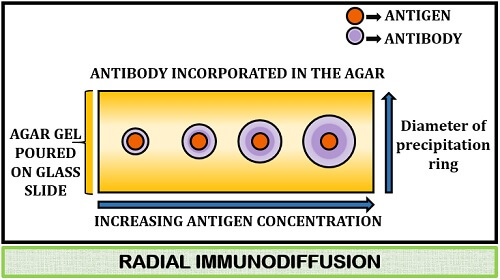
Upon incubation, the antibodies incorporated within the agar gel will react with the specific antigens. A radial diffusion occurs exterior to the well’s surface in the form of precipitin ring. The diameter of the precipitin ring is directly proportional to the concentration of the antigen.
Ouchterlony Immunodiffusion Method
It is a type of double immunodiffusion, which occurs in the two dimensions. In Ouchterlony immunodiffusion assay, add a serum into the agar gel and upon solidification of the gel matrix, create wells. The antigens are then added into the wells. This method is used to compare the homologous antigens (identical, non-identical and partially identical).
- When the antigens are identical, they will share the same antigenic determinants. Suppose, Antigen-‘A’ are the two identical types and ‘a’ as two similar epitopes. Therefore, the antigen will react with the antibody incorporated within the agar gel matrix and form an arc-shaped precipitin line or a pattern of identity.

- When the antigens are non-identical, they will not share the same epitopes. Suppose, ‘A’ and ‘B’ are two antigens and ‘a’ and ‘b’ as their respective epitopes. Therefore, the antigen will react with the antibody and form an overlapping precipitin line or a pattern of non-identity.
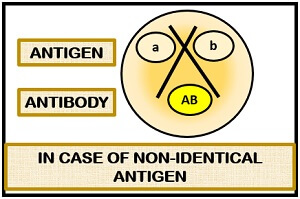
- When the antigens are partially identical, they will share one or more epitopes. Suppose, ‘A’ and ‘X’ are the two antigens and ‘ax’ and ‘bx’ as their corresponding epitopes. Therefore, the cross-reaction will occur between the antigen and antibody, which results in an incomplete precipitin line or the pattern of partial-identity.
Precipitation in Agar by Immunoelectrophoresis
This type of precipitation method involves diffusion (either in one or two directions) plus the technique of electrophoresis. The immunoelectrophoresis includes the following two methods that are given below:
Rocket Immunoelectrophoresis
It is performed on a glass slide, in which the reaction occurs in a single dimension. In Rocket immunoelectrophoresis, the agar is poured that is homogenized with the antiserum. Then, a well is created into which the antigenic suspension is added.

Upon electrophoresis, antigens being negatively charged will migrate towards the positively charged antibody. This migration of antigen on interaction with an antibody will form a complex as a visible precipitin line. We could see the precipitin line in the form of a rocket. The height covered by the precipitin line is directly proportional to the amount of antigen-loaded into the well.
Counter Immunoelectrophoresis
It is a method of immunoelectrophoresis, in which the reactants move in two dimensions. In counter immunoelectrophoresis, pour the agar gel over the glass slide.
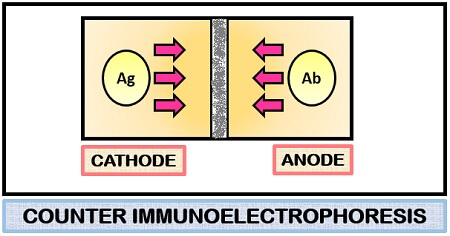
Then, create wells on both the edges of the glass slide. On one end, add antigens and on the other, add antiserum. Upon electrophoresis, the antigen will migrate towards the anode, and the antibody will migrate towards the cathode. On the interaction between antigen and antibody, a precipitin line will form.
